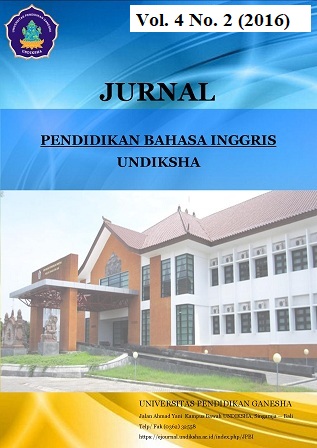AN ANALYSIS OF TEACHER AND STUDENT TALK RELATED TO THE IMPLEMENTATION OF CURRICULUM 2013 IN SMA NEGERI 4 SINGARAJA IN ACADEMIC YEAR 2016/2017
DOI:
https://doi.org/10.23887/jpbi.v4i2.9640Abstract
Penelitian ini bertujuan untuk menganalisis jenis tuturan guru dan siswa selama interaksi kelas bahasa Inggris dan menjelaskan pelaksanaan strategi pembelajaran dalam Kurikulum 2013 dalam hal jenis tuturan guru dan siswa. Penelitian dilakukan di SMA Negeri 4 Singaraja dimana subyek penelitian adalah semua guru bahasa Inggris dan siswa kelas XI di kelas XI MIA 2, XI MIA 3, XI MIA 4, XI IBB, XI IIS 1. Desain ini studi adalah analisis wacana dengan pendekatan kualitatif. Metode yang digunakan dalam penelitian ini secara konseptual mencoba untuk membuat identifikasi, mengatur, dan menganalisis dokumen untuk memahami makna. Sebagai prosedur ini penelitian, persiapan, observasi, wawancara, dan analisis yang digunakan untuk melakukan penelitian. Data dikumpulkan menggunakan lembar observasi, instrumen manusia, kamera video, dan checklist. Data yang diperoleh dianalisis dengan menyalin dan mengkodekan data melalui Flanders Analisis Interaksi Kategori (FIAC). Hasil penelitian menunjukkan bahwa: (1) semua kategori interaksi kelas berdasarkan kategori FIAC terjadi di semua proses belajar mengajar; Deals with Feelings, Praises or Encouragement, Use Students’ Ideas, Asking Questions, Lecturing, Giving Directions, Criticizes of Authority, Students’ Response, Students’ Initiation, and Silence or Confusion (2) mengajar dan kegiatan belajar sesuai dengan prinsip-prinsip pembelajaran berbasis siswa, semua guru menggunakan kategori FIAC untuk memfasilitasi mahasiswa dan untuk menerapkan pendekatan ilmiah. selebihnya, itu bisa meningkatkan pelaksanaan pembelajaran berbasis siswa dan membuat siswa terlibat secara aktif dibuktikan dengan frekuensi yang signifikan dan konsisten tuturan siswa yang terdiri dari response dan intiation.Kata Kunci : interaksi kelas, tuturan guru, tuturan siswa, pembelajaran berbasis siswa, kurikulum 2013, Flanders Interaction Analysis Categories (FIAC)
This study aimed at analyzing types of teacher and students talk during English classroom interaction and explaining the implementation of learning strategies in Curriculum 2013 in terms of the types of teacher’s and student’s talk. The study was conducted in SMA Negeri 4 Singaraja in which the subjects of the study were all the English teachers and eleventh grade students in class XI MIA 2, XI MIA 3, XI MIA 4, XI IBB, XI IIS 1. The design of this study was discourse analysis with qualitative approach. The method used in this study conceptually tries to make an identification, organize, and analyze documents in order to understand the meaning. As the present research procedures, preparation, observation, interview, and analysis were used to conduct the study. The data were collected using observation sheet, human instrument, video camera, and checklist. The data obtained were analyzed by transcribing and coding procedure of Flanders Interaction Analysis Categories (FIAC). The result of the study showed that: (1) all categories of classroom interaction using FIAC occurred in all of the teaching and learning process; Deals with Feelings, Praises or Encouragement, Use Students’ Ideas, Asking Questions, Lecturing, Giving Directions, Criticizes of Authority, Students’ Response, Students’ Initiation, and Silence or Confusion (2) the teaching and learning activities are appropriate with the principles of students centered learning, all the teachers used the categories of FIAC to facilitate the students and to apply scientific approach. Moreover, it could also arise the students centered learning and make the students engaged actively proven by the significant and consistent frequency of students talk as students’ response and students’ initiation.
keyword : classroom interaction, teacher talk, students talk, student centered learning, curriculum 2013, Flanders Interaction Analysis Categories (FIAC)
Published
2017-03-01
Issue
Section
Articles
License
Authors who publish with the Jurnal Pendidikan Bahasa Inggris Undiksha agree to the following terms:- Authors retain copyright and grant the journal the right of first publication with the work simultaneously licensed under a Creative Commons Attribution License (CC BY-SA 4.0) that allows others to share the work with an acknowledgment of the work's authorship and initial publication in this journal
- Authors are able to enter into separate, additional contractual arrangements for the non-exclusive distribution of the journal's published version of the work (e.g., post it to an institutional repository or publish it in a book), with an acknowledgment of its initial publication in this journal.
- Authors are permitted and encouraged to post their work online (e.g., in institutional repositories or on their website) prior to and during the submission process, as it can lead to productive exchanges, as well as earlier and greater citation of published work. (See The Effect of Open Access)













